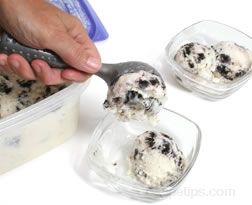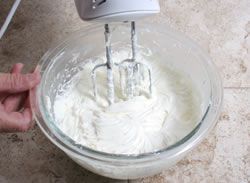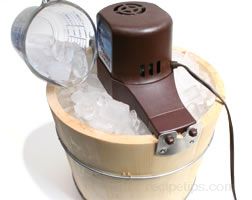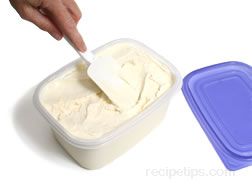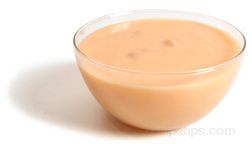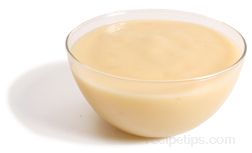When catagorizing Creams according to the fat content, those with the most fat are the Clotted and Double Creams. Clotted Cream contains a minimum of 55% fat content and is similar to Double Cream which contains at least 48% fat. Rich in flavor and thick in consistency, both varieties are concentrated dairy products that provide a depth of flavor when poured or spooned on fruit desserts, fruit salads, and a variety of sweet desserts. The Clotted and Double Creams are often added to savory food dishes such as Cream soups or risotto to deepen the richness of the flavors. When either type of Cream is whipped, it begins to thicken, changing into a spoonable Cream rather than a pourable Cream. Caution must be taken to not excessively whip the Creams. Excessive whipping or churning will result in creating a mixture that is too heavy for the intended use or creating a mixture that turns into butter. Also, prolonged whipping can create a mixture from the heavier types of Cream that begins to seperate. However, either Cream can be used for cooking since the Creams can be boiled without separating due to the high fat content within each Cream. And, both types of Cream can be frozen so they can be stored longer. When the Clotted and Double Creams are processed from a pourable cream into a stiff-textured cream, they are referred to as Extra-Thick Creams, e.g., extra thick Double Cream or extra thick Clotted Cream. The extra-thick Creams have been homogenized to create a firm texture that is not pourable but is used as a spooning Cream.
Heavy cream and Whipping Cream are the same, containing from 30% to 36% butterfat making either Cream very suitable for whipping into semi-firm tufts as the air stiffens the texture. Both types can also be served over cooked cereals or desserts to enhance the flavors of the foods being topped with the Cream. Lighter versions of these Creams are available with less fat content. Light versions of Whipping Cream contain 30% fat content which is approxomately 20% less than the non-light Whipping Cream.
Light Cream and Single Cream contain between 18% and 30% butterfat. The Light or Single Cream varieties may also be referred to as Table Creams which are typically served with coffee or used for cooking.
Half and Half is the lightest of the Creams, consisting of half light Cream and half milk, containing a minimum of 12% and up to 18% fat content. Fat-free Half and Half is made from skim milk so the creamy rich taste may be lacking, depending on the brand. When used in sauce or soup recipes, some fat-free products will have a tendency to curdle.
Sour Cream contains between 18% to 20% fat content. This type of Cream is made with the use of a natural latic acid culture that is added to create the sour and tart flavor. Other versions of this Cream are available with less fat content. Light Sour Cream contains from 14% to 16% fat while fat-free Sour Cream has no fat content. It is a product that is sold mainly for use in making snack dips, food toppings and as an ingredient in various savory food dishes.
2. A term used as a verb to describe the process of blending butter and sugar together for the purpose of smoothing the mixture before adding other ingredients to make cake batters, cookie doughs, and bread doughs. Also known as Creaming, this procedure is explained in the Glossary under the term Creaming.







